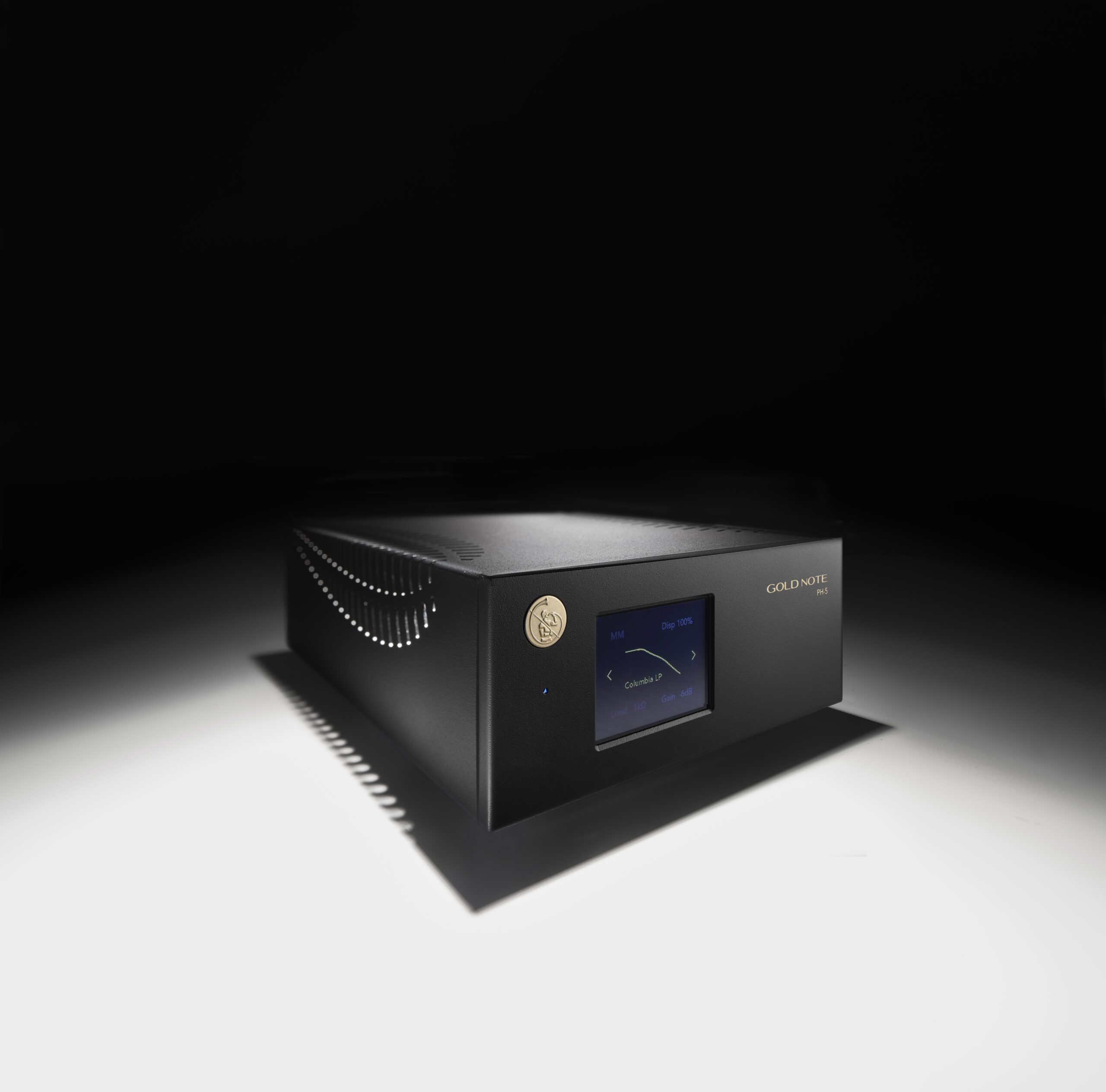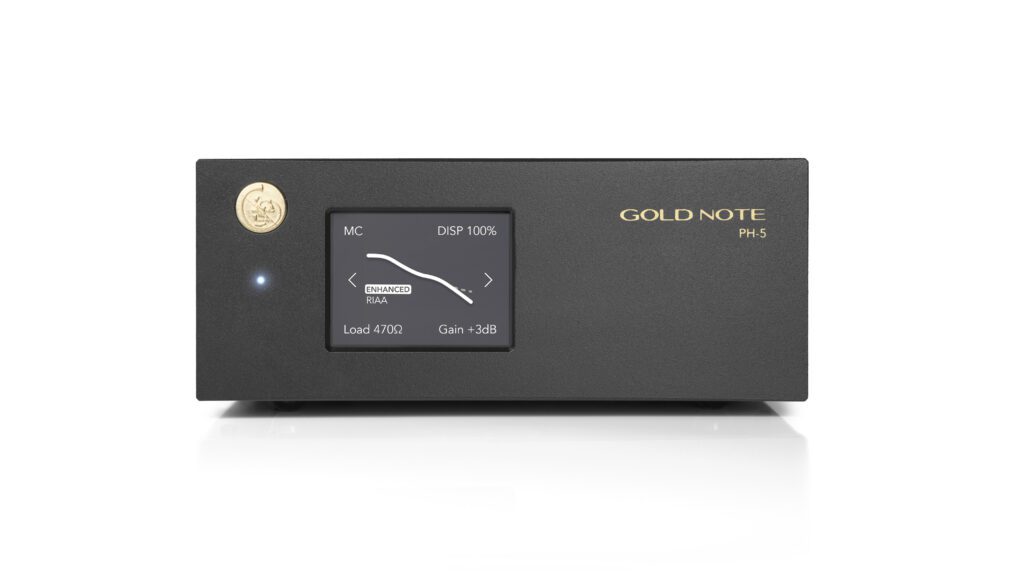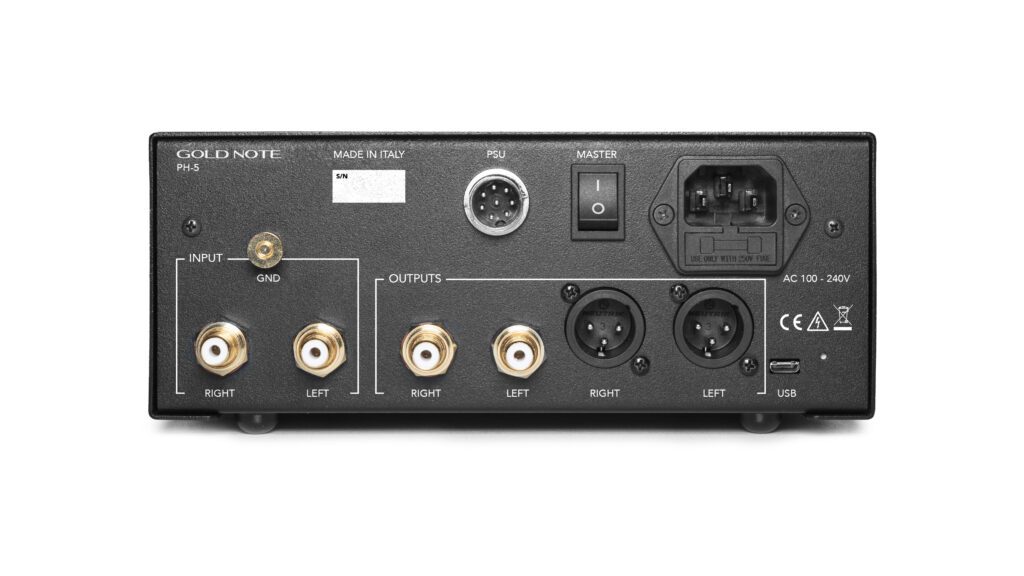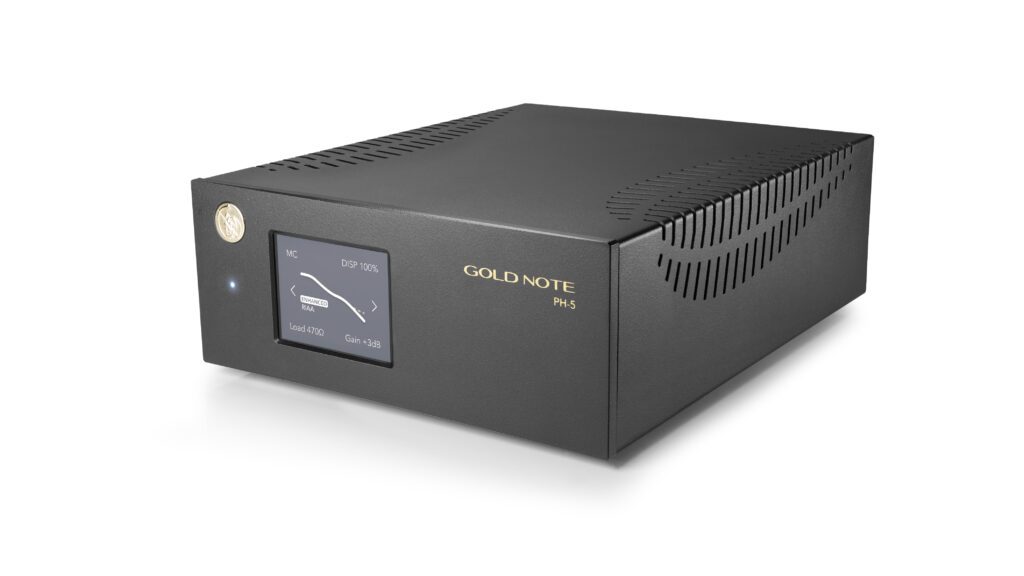
Let me say from the outset that I am already the very happy owner and user of a Gold Note phono stage. I have the company’s PH‑10 model with the optional external power supply and they have been at the heart of my reviewing system for a number of years now. Thus when the UK distributor called me to ask if I would review the latest of these small form factor devices, the PH-5, I accepted with alacrity.
Unboxing it revealed a unit that is very obviously a sibling of the PH-10. On the fascia, the control dial on the right has gone, as all the user-changeable parameters are now accessed via a touch screen. On the rear panel, the main change is that there are only a single pair of RCA input sockets with an earthing post. There are still a pair of RCA outputs, a pair of balanced XLR outputs, an IEC mains input socket with a rocker switch for power on and off and a DIN plug for connection of an external PSU.
All the adjustments
In terms of the technical specifications the PH-5, has all the adjustments one would expect – there are 9 input impedance choices from 10Ohms to 47kOhms, 4 gain options, and selectable input sensitivity. Capacitance for the Moving Magnet option is set at 220pF. Unusually among the phono stages which have come through my system, the PH-5, just like my PH-10, offers the user three different equalisation curves – RIAA, Decca London and American Columbia. Power consumption is 10W in operation and less than 0.5W in stand-by mode.
It weighs just 1.2Kg, with a modest footprint off 200mm × 80mm × 260mm (WxHxD).

I set the PH-10 on the shelf below my Linn Sondek LP12 and alongside the PH-10 PSU, and attached the arm leads, ground lead and pair of Audioquest Pegasus RCA interconnects. The cartridge in the Linn Ittok arm throughout the review was my trusty moving coil Dynavector XX2. The output cables were connected to an appropriate input on my PrimaLuna EVO400 integrated amplifier. I inserted a Shunyata Research Delta mains lead that was plugged into the same company’s Hydra6 power distribution block.
Speakers used during the review period were initially Harbeth Compact7E-S XDs, then Kudos Titan606s and then back to the Harbeths. Speaker cable was Audioquest Robin Hood.
All that remained was to power the unit on then to keep a finger on the touchscreen to bring to full operation from standby. By touching each changeable parameter on the screen I was able to select MC, RIAA, 22kOhms and gain of +3dB, faster than it has taken me to type the words. I put my ear to the Harbeth grille and was met with complete silence – not a hint of noise coming through from the PH-5.
Listening to the PH-5
Having been advised by the distributor that this was a brand new unit, I thought it was only fair to spend a couple of days of playing before settling down to some serious listening. However, as I walked away having put the first side of Analogue Productions” excellent 2018 double album compilation The Wonderful Sound Of Female Vocals (APP122), Julie London’s voice singing ‘Cry Me A River’ stopped me in my tracks. I ended up spending the next couple of hours playing all four sides of that first album choice. It was an absorbing listen, with each of the voices coming through with wonderful realism. The PH-5 picked up on every tiny detail and fed it through to the amplifier.

Thus went my first few days with the PH-5. Every record that I played came through with that special magic dust that we vinylistas crave. The EVO400 has that almost organic quality to its sound signature that, paired with the Harbeths’ very naturalistic presentation, is a sonic world that I find exceptionally easy to spend many hours with. The PH-5 does not overdo things in terms of adding another layer of warmth, it just seems to let the music retrieved from the turntable flow without artifice.
The first three days went by quickly but on the fourth day, having selected several albums from the shelves, I teed up one of my favourites, Gary Karr’s recording on the Firebird/Cisco label (CLP7058) of Rodrigo’s ‘En Aranjuez Con Tu Amor’, which is also the title of the album. I have a particular love of double bass music, and Mr Karr is among its finest practitioners. Accompanied by Harmon Lewis on organ on some tracks and piano on others, Mr. Karr delivers eight tracks of exquisite beauty. Through the PH-5 the wonderful tonality of his 1995 James Ham instrument shines through, and the emotional impact of the whole recital left me sitting motionless for several minutes after the final notes of Barber’s ‘Adagio For Strings’ faded on the closing track. Mesmerising stuff.
Composure regained
Having regained my composure I then attached my own PH-10 PSU to the PH-5 (the distributor had assured me of the compatibility in our initial discussion) via the umbilical DIN cable. With no thought to my emotional safety I then played both sides of the album again. As I had long since discovered with my PH-10, the PSU took the performance of the less expensive PH-5 to a new level. The sense of the horsehair bow in Mr. Karr’s skilled hand moving across the strings of his instrument was almost holographic, and I was transported from a seat half way back in the recording venue to somewhere very near the front. There was definitely better definition in those vital lower octaves but further up the frequency range there was an audible increase in the realism of the listening experience.
It was at about this time that I had to switch amplifiers, and exchanged the PrimaLuna for my other amplifier, which is the polar opposite, the Lyngdorf TDAI3400. This is an all digital design, in which is fitted Lyngdorf’s optional (though in my case necessary) upgraded analogue import board, which gives the option of using both XLR and RCA interconnects. I therefore switched to the Audioquest Pegasus XLR cables. Fancying a change of pace I cued up my 1971 copy of Osibisa’s Woyaya on the MCA label (MDKS8005). Recorded at Air Studios in London, with Tony Visconti producing, this in 1971 was one of my first forays into what later became known as world music. The seven musicians of the band were variously from Ghana, Nigeria, Grenada, Antigua and Trinidad, making Osibisa a truly Afro-Caribbean ensemble. I saw them live just after this album was released and the gig still sits among my favourite live musical experiences. They play with joy, verve and fantastic interaction, all of which is very well captured on this disc. Through the PH-5/PSU the sense of being there in the studio is real, and both sides were despatched in the twinkling of an eye, with the listener grinning broadly and clapping along to the complex rhythms being created. On stage, the bassist Spartacus R had real presence, and his instrument anchored the whole performance. On record, Mr. Visconti and his engineer John Punter had done a wonderful job of capturing that powerful growl. The PH-5 did it full justice too.
The big album pile
My play pile of albums grew bigger and bigger. I shall not bore you with a list, but I played heavy metal, classic rock, pop, jazz, classical (both instrumental and choral), folk, reggae – in fact a complete snapshot of my musical taste, and the PH-5 just kept delivering. In the ensuing days and weeks I tried switching back from the XLRs to the RCA interconnects, but always returned to the XLRs as, to my ears at least, I felt there was a subtle but audible improvement to the sound. I am pleased that Gold Note have carried the option of cable interface forward from the more expensive PH-10. A company less committed to meeting audiophile needs might have been tempted to offer RCA only.
Speaking of interfaces, the PH-5’s touchscreen is a delight to use. It is responsive to a light touch and allows the user to switch between MC and MM setting, with the latter having fixed values but with the MC offering all sorts of options. You can also dim the display.

MY LP12 sits on top of the rack, with the phono stage and PSU on the shelf below. I have discovered that the player is very sensitive to any touch on other parts of the rack, so that changing parameters on the PH-10 via its small dial has to be done before the arm is lowered to the record. The PH-5 screen requires a bare minimum of a finger tip touch to change, meaning I was able to change settings while a record was playing. And I did just that, including changing the EQ between the three options, which was very interesting. The differences are subtle as I would have expected, the Dynavector sounded best through the RIAA, with impedance of 220Ohms and +3dB of gain applied.
As mentioned earlier, during the review period a pair of Kudos Titan606s arrived in my listening room and I played again several of the albums that had been used previously. The Titan606s average in-room response is rated to go down to 30Hz, which gave me another chance to hear Gary Karr and the extra bass information compared with the Harbeths (which start to roll off at 45Hz), and I was not disappointed. The PH-5 is not outclassed in the company of much more expensive equipment. Switching back to the Harbeths did not feel retrogressive however, just different, and they are probably more in keeping with the PH-5 from a purchase price point of view.
Final Thoughts
There is no doubt that Gold Note have come up with another class leader in the PH-5. For comparison purposes I replaced the guest piece with my own PH-10 more than once in the review period, and without having proper calibration equipment I thought that they sounded remarkably similar. There was a tad more weight to recordings played through the more expensive device but whether that would be sufficient to make me stump up the extra cost if I were buying again, I am honestly not sure. The matching PSU may already be available by now, and I would strongly recommend adding one to your PH-5 order.
For a small (about 30 people strong) Florentine company, Gold Note continues to produce excellent products, all of which are not just highly functional but are very stylish too. With record sales, at least here in the UK, having overtaken CD sales in the last 12 months, the Gold Note PH-5 gives new vinyl users an affordable way into the world of high performance kit. It deserves to sell in large numbers and should be added to any shortlist of equipment to audition by those looking to move forward from, for example, the built in phono stage in an amplifier. I can only give this the highest recommendation. Bravissimo Gold Note.
Technical specifications
- Type Solid-state phono preamplifier with equalization curve adjustment
- Inputs 1× stereo RCA pair (MM/MC), with earth tag
- Input Sensitivity 0.1mV (MC) up to 10mV (MM)
- Input impedance 10Ω–47kΩ (in nine steps)
- Gain MM; 40dB, MC; 60dB (with four options; 0dB, +3dB, ±6dB)
- Capacitance (MM Only) 220pF
- Outputs 1× stereo RCA pair, 1× stereo balanced XLR pair
- Output Impedance 50Ω
- Equalisation Curves RIAA, Decca, Columbia, all with ‘Enhanced’ option
- Infrasonic filter 10Hz, 36dB/octave
- Frequency response 20Hz–20kHz ±0.3dB (Enhanced mode, 20Hz–50kHz ±0.3dB)
- THD < 0.05% @ 1kHz
- Signal-to-noise Ratio 89dB
- Dynamic Range 105dB
- Dimensions (W×H×D) 20 × 8 × 26cm
- Weight 1.2kg
- Price £949
Manufacturer
Gold Note
Homepage – https://www.goldnote.it
PH-5 – https://www.goldnote.it/phono-stages/ph-5/
Distributors – https://www.goldnote.it/distributors/
UK distributor
+44(0)754 879 6382
Tags: GOLD NOTE PH-5 PHONO STAGE
By Chris Kelly
More articles from this authorRead Next From Review
See all
Reiki Audio SuperSwitch Master Pro + Servant Pro
- Mar 27, 2024

Melco Audio N1-S38 music server
- Mar 27, 2024

Focal Utopia 2022 headphones
- Mar 27, 2024











